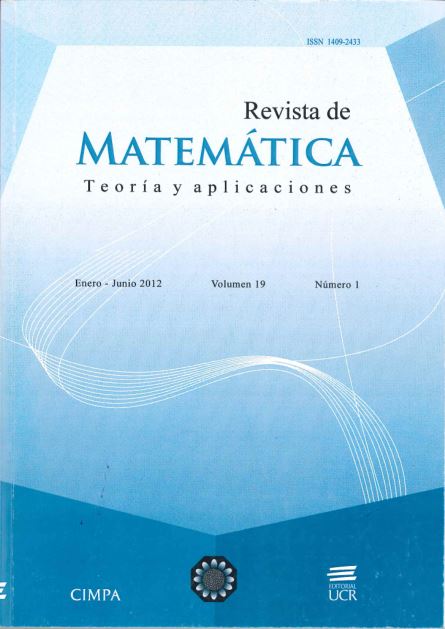Abstract
This paper describes a general procedure to do Bayesian inference based on the likelihood evaluation of the stochastic general equilibrium models (MEGE) through Markov Chain Monte Carlo methods (MCMC). The proposed methodology involves log linearizing the model, transformed into state space form, then use the Kalman filter to evaluate the likelihood function and finally apply the Metropolis Hastings algorithm to estimate the posterior distribution parameters. Technique is illustrated using the stochastic growth of basic model, considering quarterly data on the Venezuelan economy between the first quarter of (1984) through the third quarter of (2004). The empirical analysis made allows us to conclude that the algorithms used to estimate the model parameters work efficiently and low computational cost, the estimates obtained are consistent, that is, estimates of the predictions adequately reflect the behavior of the product, employment, consumption and investment per capita in the country. The graphs of the estimated histograms show bimodal and skewed distributions.
References
Basdevant, O. (2003) “On applications of state-space modeling in macroeconomics”, Discussion Paper Series, Reserve Bank of New Zeland, DP2003/02 : 1–30.
Cass, D. (1965) “Optimum growth in an aggregative model of capital accumulation”, Review of Economic Studies 32(3): 233-240.
Chib, S.; Greenberg, E. (1995) “Understanding the Metropolis-Hasting algorithm”, The American Statistical Association 49: 327–335.
Christiano, L.; Eichenbaum, M.; Evans, C. (2001) “Nominal rigidities and the dynamic effects of a shock to a monetary policy”, Working Paper no. 8403, NBER, Cambridge, MA.
Cooley, T.; Prescott, E. (1995) Economic growth and business cycles. In: T.F. Cooley (Ed.) Frontiers of Business Cycle Research. Princenton University Press, Princeton NJ.
De Jong, D.; Ingram, B.; Whiteman, C. (2000) “A Bayesian approach to dynamic macroeconomics”, Journal of Econometrics 98: 203–223.
Fernández-Villaverde, J.; Rubio-Ramı́rez, J.F. (2004) “Comparing dynamic equilibrium models to data: a Bayesian approach”, Journal of Econometrics 123(1): 153–187.
Fernández-Villaverde, J.; Rubio-Ramı́rez, J.F. (2005) “Estimating dynamic equilibrium economies: linear versus nonlinear likelihood”, Journal of Applied Econometrics 20(7): 891–910.
Fernández-Villaverde, J.; Rubio-Ramı́rez, J. (2006) “Solving DSGE models with perturbation methods and a change of variables”, Journal of Economic Dynamics and Control 30(12): 2559–2531.
Fernández-Villaverde, J.; Rubio-Ramı́rez, J.; Sargent, T.; Watson, M. (2007) “A,B,C´s (and D)´s for understanding VARs”, The American Economic Review 97(3): 1021–1026.
Geweke, J. (1998) “Using simulation methods for Bayesian econometrics models: inference, development and communication”, Federal Reserve Bank of Minneapolis Research Department Staff Report 249.
Hastings, W. (1970) “Monte Carlo sampling methods using Markov Chains and their applications”, Biometrika 57(1): 97–109.
Harvey, A. (1989) Forecasting, Structural Time Series Models and the Kalman Filter. Cambridge University Press, Cambridge.
Kalman, R. (1960) “A new approach to linear filtering and prediction problems”, J. Basic Engineering82 series D: 35–45.
Koopmans, T. (1965) On the Concept of Optimal Economic Growth. The Econometric Approach to Development Planning. North Holland, Amsterdam.
Koopman, S.; Bos, C. (2004) “State space models with a common stochastic variance”, Journal of Business and Economic Statistics 22(3): 346–357.
Landon, L. (1999) Bayesian Comparison of Dynamic Macroeconomic Models. Ph.D Thesis, University of Minnesota.
Metropolis N.; Rosenbluth, A.; Rosenbluth, M.; Teller, A.; Teller, E. (1953) “Equation of state calculations by fast computing machines”, The Journal of Chemical Physics 21(6): 1087–1092.
Ord, J.; Koehler, A.; Snyder, R. (1997) “Estimation and prediction for a class of dynamic nonlinear statistical models”, Journal of the American Statistical Association 92(440): 1621–1629.
Otrok, C. (2001) “On measuring the welfare cost of business cycles”, Journal of Monetary Economics 47(1): 61–92.
Rabanal, P.; Rubio, J. (2005) “Comparing new Keynesian models of the business cycle: a Bayesian approach”, Journal of Monetary Economics 52(6): 1151–1166.
Sargent, T. (1989) “Two models of measurements and the investment accelerator”, The Journal of Political Economy 97(2): 251–287.
Schorfheide, F. (2000) “Loss function-based evaluation of DSGE models”, Journal of Applied Econometrics 15(6): 645–670.
Smets, F.; Wouters, R. (2003) Shocks and frictions in US business cycles: a Bayesian DSGE approach. Mimeo. European Central Bank, Frankfurt, 58 pages. In: http://papers.ssrn.com/sol3/papers.cfm?abstract_id=1687574.
Uhlig, H. (1995) A toolkit for analyzing nonlinear dynamic stochastic models easily. Discussion Paper 1010, Institute for Empirical Macroeconomics, Federal Reserve Bank of Minneapolis, 22 pages.
